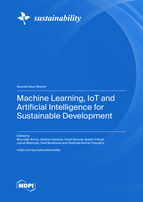Machine Learning, IoT and Artificial Intelligence for Sustainable Development
A special issue of Sustainability (ISSN 2071-1050).
Deadline for manuscript submissions: closed (15 September 2023) | Viewed by 36285
Special Issue Editors
Interests: water quality modeling; IoT and smart devices; internet of things; water quality
Special Issues, Collections and Topics in MDPI journals
Interests: computer sciences; Industry 4.0; network security; computer networking
Interests: machine learning; AI; data science
Interests: IoT; security; authentication
Interests: environment; monitoring systems; water management
Special Issues, Collections and Topics in MDPI journals
Interests: VANET; smart grid; smart transportation
Interests: cryptography; Internet of Things; authentication; authenticated encryption; blockchains; 6G communication
Special Issues, Collections and Topics in MDPI journals
Special Issue Information
Dear Colleagues,
Nowadays, the newest technologies, devices and techniques related to IoT, machine learning and artificial intelligence are constantly developing. Therefore, they have a significant impact on the sustainability of our lifestyles. Accordingly, the application domain of these technologies and tools involves agriculture, water management, healthcare, bioinformatics, smart grids, smart cities, security, and so on. In addition, the IoT has brought an innovative perspective that is totally distinct from the usual approaches: the former consists of a device that can communicate with the network and is capable of implementing intelligent solutions. The goal of this Special Issue is to create a common gateway between researchers, allowing them to exchange and share their results related to the application of IoT, artificial intelligence and machine learning in various domains.
Dr. Mourade Azrour
Dr. Azidine Guezzaz
Dr. Imad Zeroual
Dr. Azeem Irshad
Dr. Jamal Mabrouki
Dr. Said Benkirane
Dr. Shehzad Ashraf Chaudhry
Guest Editors
Manuscript Submission Information
Manuscripts should be submitted online at www.mdpi.com by registering and logging in to this website. Once you are registered, click here to go to the submission form. Manuscripts can be submitted until the deadline. All submissions that pass pre-check are peer-reviewed. Accepted papers will be published continuously in the journal (as soon as accepted) and will be listed together on the special issue website. Research articles, review articles as well as short communications are invited. For planned papers, a title and short abstract (about 100 words) can be sent to the Editorial Office for announcement on this website.
Submitted manuscripts should not have been published previously, nor be under consideration for publication elsewhere (except conference proceedings papers). All manuscripts are thoroughly refereed through a single-blind peer-review process. A guide for authors and other relevant information for submission of manuscripts is available on the Instructions for Authors page. Sustainability is an international peer-reviewed open access semimonthly journal published by MDPI.
Please visit the Instructions for Authors page before submitting a manuscript. The Article Processing Charge (APC) for publication in this open access journal is 2400 CHF (Swiss Francs). Submitted papers should be well formatted and use good English. Authors may use MDPI's English editing service prior to publication or during author revisions.
Keywords
- machine learning, IoT and AI for smart systems
- machine learning, IoT and AI for environment and health
- machine learning, IoT and AI for air, water and climate sustainability
- machine learning, IoT and AI for smart energy, renewable energy and green fuel
- machine learning, IoT and AI for smart cities
- smart communication and networking technologies
- big data and smart systems
- biometrics and smart systems
- cloud/edge/fog computing technologies for smart systems
- IoT and industrial IoT technologies for smart system
- authentication and authorization
- security of private data
- blockchain-related applications for intelligent IoT trust, security and privacy
- big data analytics in IoT systems












